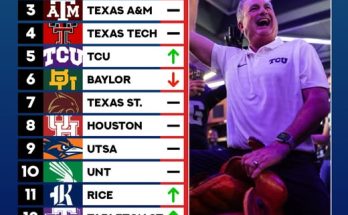The Atlantic Coast Conference handed down a $50,000 fine to Florida State University following the wild celebration that erupted after their monumental victory, when Seminoles fans stormed the field in unrestrained joy. While on paper this may appear like a disciplinary measure, in reality, it represents the age-old push and pull between conference regulations, fan passion, and the priceless moments that define the culture of college football. For Florida State and its faithful, that $50,000 fine is less a punishment and more a receipt for an unforgettable night of triumph, joy, and collective pride. The sentiment spreading across social media and fan bases alike says it all: “Worth every penny.” To truly understand why this fine is being met with smiles rather than groans, one has to look deeper into the context of the game, the history of storming the field in college football, and what these moments mean to both fans and the programs they support.
Florida State’s recent resurgence has reignited passion across Tallahassee. After years of struggles and doubts about whether the Seminoles could once again return to national prominence, this season has marked a statement: Florida State football is not only relevant, but dangerous. When the team delivered a victory against a top-ranked opponent, Doak Campbell Stadium erupted. The roar of more than 70,000 fans shook the ground, and before long, thousands rushed from the stands to celebrate with the team. The scene was a wave of garnet and gold spilling across the turf, a chaotic yet beautiful display of what makes college football unlike any other sport. Students, alumni, and lifelong fans wanted to be part of history, to touch the moment rather than just observe it. And so they ran—onto the field, into the heart of the story being written in real time.
The ACC, of course, has rules in place. Field storming has become one of the most controversial traditions in college sports. Conferences argue that it poses safety risks for players, coaches, referees, and even the fans themselves. In the past, there have been injuries ranging from sprained ankles to serious collisions when security could not control the crush of humanity spilling onto the grass. With safety and liability in mind, the ACC follows the lead of other conferences such as the SEC and Big Ten, issuing significant fines to schools whose fans rush the field or court. The $50,000 figure is not random; it is part of a tiered structure where repeat offenders face even steeper penalties, sometimes into the six figures. To conferences, the fines act as deterrents. To fans, however, they are seen more as the cost of doing business—an unavoidable tax on euphoria.
What makes this particular fine noteworthy is the reaction it sparked among Seminoles fans. Instead of anger at the penalty, there was a collective shrug, followed by a sense of pride. Social media flooded with memes, jokes, and declarations that $50,000 was a bargain for the kind of memory created that night. Alumni pledged donations, students posted about starting GoFundMe campaigns, and boosters joked that they’d cover the fine themselves. In other words, the fine wasn’t a source of embarrassment—it was a badge of honor. Florida State’s return to the national stage, validated by such a victory, was a moment worth celebrating recklessly, and the cost seemed insignificant compared to the emotional value.
This response highlights a broader truth about college football culture. Field storming has long been part of the DNA of the sport. It is not about disrespecting the opponent or disregarding safety rules—it is about passion spilling over the boundaries of structure. These moments happen when a program achieves something so seismic, so against the odds, or so symbolically important that fans feel compelled to join the players on the field. It is, in a sense, the ultimate form of communal celebration, where the barrier between spectator and participant collapses. For Florida State, it wasn’t just about beating a tough opponent; it was about validation, about proving that the program is once again part of the national conversation. When viewed through that lens, the fine becomes less a punishment and more a receipt for proof that the Seminoles had delivered a game worth storming for.
There’s also the economic reality to consider. A $50,000 fine may sound steep, but for a program like Florida State, it is far from crippling. The Seminoles’ athletic department brings in tens of millions annually, largely from football revenue alone. Ticket sales, television deals, merchandise, and booster contributions create a financial ecosystem where such fines are, relatively speaking, a drop in the bucket. More importantly, the kind of energy and publicity generated by a field storming arguably outweighs the cost. Highlight reels of the fans rushing the field made national news. Clips circulated on ESPN, TikTok, Instagram, and Twitter. The brand exposure, the recruiting impact, and the boost to school spirit were worth far more than $50,000. Prospective recruits saw not just a winning team, but a fan base that cares deeply, a program alive with energy, and a stadium atmosphere that can compete with anyone in the country. For coaches on the recruiting trail, those images are gold.
At the same time, the debate over whether conferences should continue fining schools for such incidents is intensifying. Many argue that no amount of fines will stop fans from storming the field when the moment calls for it. History shows that fans weigh the thrill of the moment far more heavily than the abstract notion of a fine that their university—not they themselves—will have to pay. If anything, the tradition of rushing the field may only be reinforced by the fines, as fans wear it as a point of pride that their joy was “too big to contain.” On the other hand, conferences must think about liability, player safety, and order. It is not hard to imagine a scenario where a player is seriously injured in the chaos, and lawsuits follow. In that sense, fines are less about stopping the behavior and more about signaling that the conference is officially against it, providing a kind of legal insulation.
For Florida State, the timing of this fine also adds an extra layer of meaning. This is a program that has been fighting for recognition and respect in recent years, especially in the broader landscape of college football realignment. With ongoing conversations about whether the Seminoles might eventually leave the ACC for another conference, some fans saw the fine as yet another symbol of the strained relationship between FSU and the league. While the university itself has not suggested that the fine was unfair, the optics of punishing a program for being too successful only adds fuel to the debate about whether the ACC truly supports Florida State at the level it deserves. Fans, meanwhile, have doubled down on their pride, seeing the fine as a sign that the program is back to being feared and relevant—something no penalty can take away.
Culturally, the incident reinforces why college football is so beloved. Unlike professional sports, where fans are often more restrained and stadiums more controlled, college football thrives on its unpredictability and its raw emotional energy. The sight of students climbing fences, rushing onto the turf, hugging players, and taking selfies at midfield is part of what makes the sport so magnetic. These are not just spectators—they are part of the story, part of the memory that players and fans will carry for life. Ask anyone who was on that field, and they will say that the $50,000 fine pales in comparison to the memory of standing shoulder to shoulder with the team as the stadium shook with joy.
There is also an educational angle here for programs nationwide. Universities know that storming the field will always carry risks, but many are now investing in strategies to make the tradition safer. Some schools have trained security teams to direct the flow of fans onto the field in a controlled manner, minimizing chaos. Others use communication systems to warn fans of potential risks. Florida State, like many schools, will likely evaluate its protocols, but the truth is that no policy will stop the spontaneous flood of humanity when the moment feels right. The best universities can do is accept that these moments will happen and prepare accordingly.
At its core, this fine and the reaction to it tell us something essential about college football fandom. For the people who love the sport, the game is not just about wins and losses—it is about community, tradition, and memory. The night that led to Florida State’s fine was not simply another Saturday in the fall; it was a night when the Seminoles proved something to themselves and to the world. It was a night when fans felt the weight of history and responded with uncontainable joy. The $50,000 fine is a footnote in that story, a minor financial penalty attached to a priceless emotional moment. And when fans say it was worth every penny, they mean it.



